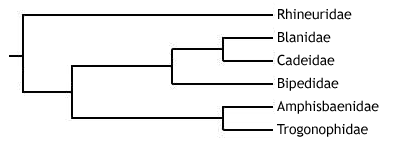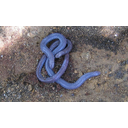Amphisbaenia
Amphisbaenia - worm lizards
| Lepidosauria; Squamata; Amphisbaenia |
The Amphisbaenia are a poorly known group of limbless
burrowing squamates, called amphisbaenians, or worm lizards. While the monophyly of Amphisbaenia is well supported, their affinities to other
squamate groups remain unresolved. For more information regarding the position
of the Amphisbaenia in squamate phylogeny, please refer to the Squamata main
page.
Diversity and Lower Taxonomy:
There are
approximately 169 species of amphisbaenian, contained within 24
well-established genera. The position of these genera at the family-level,
however, has been the subject of scientific debate.
In 2003,
- Bipedidae - conaining
three species in the single genus Bipes. These are the only
amphisbaenians to have forelimbs.
- Blanidae - containing four
species in the genus Blanus.
- Amphisbaenidae -
containing 153 species divided between 13 genera. The most speciose genus
is Amphisbaena (69 species).
- Trogonophidae - containing
six species in four genera.
- Rhineuridae - containing
the monospecific Rhineura floridana.
The family status
of the four remaining genera - Aulura, Dalophia, Leposternon, and Monopeltis - was not resolved, but they were placed in the
superfamily Rhineuroidea with the family Rhineuridae. These are united by the
possession of a shovel-like skull shape, amongst other characteristics (see
below).
See below for the synapomorphies of these clades.
Since

An even more recent
study (Vidal et al. 2007) proposed, using molecular and
biogeographic evidence, that the Cuban genus Cadea should be removed from the family Amphisbaenidae,
and placed in its own new family, Cadeidae, as sister group to Blanidae. The Blanidae-Cadeidae clade was sister to the Bipedidae, together forming the sister
group to the Amphisbaenoidea. Like Macey et al. (2004), Rhineuridae was the first
family to diverge.

Description
Amphisbaenians are highly specialised for a fossorial (burrowing) mode of
life. Almost all are completely limbless, except the three species of the
Mexican genus Bipes, which have small, well-developed forelimbs. All are
elongate, ranging in size from around 10 to 70 cm, with a long trunk region and
short tail (the musculature required for burrowing is present in the trunk).
They have an extremely distinctive skin, consisting of conspicuous rings of
scales, called annuli, that encircle the trunk. Only loosely connected to
the main trunk, this specialised integument forms a tube in which the animal
can move forwards and backwards. This is key to the ability of amphisbaenians
to burrow. An amphisbaenian can use longitudinal muscular contractions between
each annulus to bunch up the skin in order to anchor a part of the body in the
soil. Trunk muscles can then be used to move the body forward within the
integumentary tube. The front can then be anchored whilst the posterior integument
is brought forward, after which the cycle can restart, allowing the
amphisbaenian to advance.
Amphisbaenians are headfirst burrowers, and so the skull is highly modified for
digging. While all have a rigid, compact skull, there are three main
amphisbaenian skull types, which are functionally related to the way in which
they burrow:
- "Shovel-headed" (e.g. Rhineura and Leposternon)
- dorsoventrally
flattened snout, with a sharp craniofacial angle. Amphisbaenians with this
skull form dig by forcing the head forwards and slightly downwards, and
then lifting the head dorsally
to pack the soil onto the top of the tunnel. The sides of the tunnel are
smoothed with the pectoral musculature.
- "Spade-headed" (trogonophids) - again a dorsoventrally
flattened snout, with a strong craniofacial angle. The burrowing method,
is however, quite distinct. Trogonophids use the sharp sides of their head
(called lateralcanthi)
to shave off soil from the front of the tunnel in an oscillatory motion.
Soil is pushed and packed using the sides of the head and the body.
- "Keel-headed" (e.g. Anops and Mesobaenia)
- laterally
compressed head. These amphisbaenians dig by ramming the head forwards,
and then push and pack soil rearwards by forcing the head alternately left
and right.
- "Round-headed" or "bullet-headed" (the majority
of amphisbaenians, e.g. Amphisbaenia, Blanus, Cadea,Zygaspis) -
dig by using the head as a simple battering ram, followed by pushing the
head in different directions to pack soil.
While the majority
of amphisbaenians have a similar appearance, close to that described above,
some are more distinct, and warrant further description. As already noted,
members of the family Bipedidae (genus Bipes) have functional forelimbs. These are used for the
initial surface excavation of a tunnel, and the first digit possesses extra
phalanges to increase the efficiency of this digging process.
The trogonophids
(family Trogonophidae) also have some features that make them distinct. First,
they have a triangular cross-section, as opposed to cylindrical. Second, they
have an acrodont dentition, in contrast to the pleurodont dentition of other
amphisbaenians. Third, they do not exhibit caudal autotomy (the ability to self-amputate
the tail). Finally, they are "spade-headed" and exhibit a unique
burrowing behaviour (see above).
Distribution and Habitat:
While the majority of amphisbaenians are located
in Africa and South America (members of Amphisbaenidae, Blanidae,
and Trogonophidae), others are present in
All amphisbaenians burrow in soil or dry, loose
sand.
Conservation Status (IUCN):
Only nine species
of amphisbaenian are present on the IUCN Red List. All of these are listed as Least Concern (LC), and have been assessed since at least 2006.
Synapomorphies of the Amphisbaenia and its families (sensu Kearney 2003):
o
Amphisbaenia:
o
High degree of cranial consolidation.
o
Brain completely surrounded by frontal bone (anteriorly)
and enlarged, azygous orbitosphenoid plate (ventrally).
o
Presence of annuli - ring-like arrangement of scales.
o
Enlarged median tooth in the premaxillary bone of the upper jaw.
This tooth fits into a groove between the two lower teeth, forming an efficient
'nipper' that can take a chunk of flesh from its prey.
o
Modified extracolumellar system of the ear, sensitive to low
frequency sounds - improving subterranean hearing.
o
Absence of the epipterygoid.
o
Right lung reduced in size or lost (in contrast to other
limbless squamates, which show reduction of the left lung).
o
Family Bipedia only:
o
Presence of (functional) forelimbs, with anteriorly
shifted pectoral girdle.
o
Fused fronto-parietal complex.
o
Digit I exhibits polyphalangy (the presence of extra phalanges).
o
Family Blanidae only:
o
Reduced clavicles.
o
Anteriorly
truncated nasals.
o
Family Amphisbaenidae only:
o
Absence of squamosal.
o
Absence of the sternum.
o
Family Trogonophidae only:
o
Acrodont dentition.
o
Absence of caudal autotomy - no fracture planes to
self-amputate.
o
Strong craniofacial angle.
o
Enlarged sternal plate.
o
Short tail.
o
Family Rhineuridae only:
o
Anterior edge of the snout is squared-off.
o
External naris opens ventrally.
o
Pterygoid vomer contact.
o
Absence of posterodorsal rib processes.
Licensed under the Creative Commons Attribution Non-commercial Share Alike 3.0 License
'Vertebrate Diversity' has been released as an open educational resource (OER) on a Creative Commons 'Attribution Non-commercial Share Alike' license. This means that once downloaded, content can be modified and improved to complement a particular course. This requires, however, that improvements are recycled back into the OER community. All content present at the time of download must be accordingly credited and, in turn, novel content must be appropriately licensed. For more information, please refer to the license deed by clicking on the link above.
